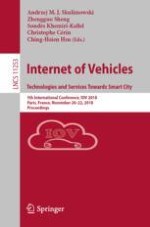2018 | Buch
Internet of Vehicles. Technologies and Services Towards Smart City
5th International Conference, IOV 2018, Paris, France, November 20–22, 2018, Proceedings
herausgegeben von: Prof. Andrzej M.J. Skulimowski, Dr. Zhengguo Sheng, Sondès Khemiri-Kallel, Christophe Cérin, Ching-Hsien Hsu
Verlag: Springer International Publishing
Buchreihe : Lecture Notes in Computer Science
